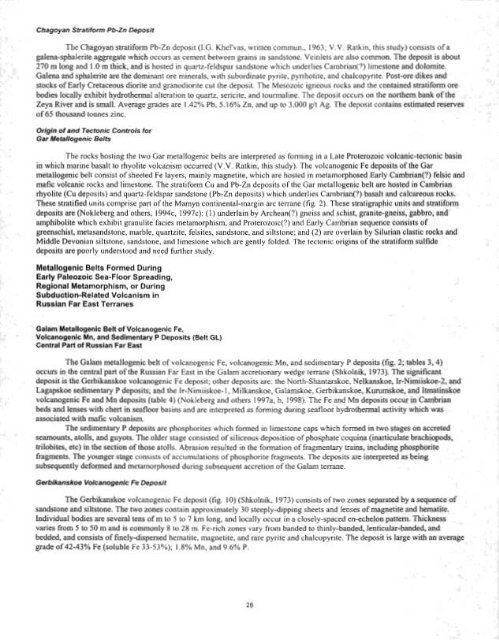Metallogenesis and Tectonics of the Russian Far East, Alaska, and ...
Metallogenesis and Tectonics of the Russian Far East, Alaska, and ...
Metallogenesis and Tectonics of the Russian Far East, Alaska, and ...
You also want an ePaper? Increase the reach of your titles
YUMPU automatically turns print PDFs into web optimized ePapers that Google loves.
Chagoyan Stratiforrn Pb-Zn Deposit<br />
The Chagoyan stratiform Pb-Zn deposit (I.G. Khel'vas, written commun., 1963; V.V. Ratkin, this study) consists <strong>of</strong>a<br />
galena-sphalerite aggregate which occurs as cement between grains in s<strong>and</strong>stone. Veinlets are also common. The deposit is about<br />
270 m long <strong>and</strong> 1.0 m thick, <strong>and</strong> is hosted in quartz-feldspar s<strong>and</strong>stone which underlies Cambrian(?) limestone <strong>and</strong> dolomite.<br />
Galena <strong>and</strong> sphalerite are <strong>the</strong> dominant ore minerals, with subordinate pyrite, pyrrhotite, <strong>and</strong> chalcopyrite. Post-ore dikes <strong>and</strong><br />
stocks <strong>of</strong> Early Cretaceous diorite <strong>and</strong> granodiorite cut <strong>the</strong> deposit. The Mesozoic igneous rocks <strong>and</strong> <strong>the</strong> contained stratiform ore<br />
bodies !ocally exhibit hydro<strong>the</strong>rmal alteration to quartz, sericite, <strong>and</strong> tourmaline. The deposit occurs on <strong>the</strong> nor<strong>the</strong>rn bank <strong>of</strong> <strong>the</strong><br />
Zeya River <strong>and</strong> is small. Average grades are 1.42% Pb, 5.16% Zn, <strong>and</strong> up to 3,000 g/t Ag. The deposit contains estimated reserves<br />
<strong>of</strong> 65 thous<strong>and</strong> tomes zinc.<br />
Origin <strong>of</strong> <strong>and</strong> Tectonic Controls for<br />
Gar Metallogenic Belts<br />
The rocks hosting <strong>the</strong> two Gar metallogenic belts are interpreted as forming in a Late Proterozoic volcanic-tectonic basin<br />
in which marine basalt to rhyolite volcanism occurred (V.V. Ratkin, this study). The volcanogenic Fe deposits <strong>of</strong> <strong>the</strong> Gar<br />
metallogenic belt consist <strong>of</strong> sheeted Fe layers, mainly magnetite, which are hosted in metamorphosed Early Cambrian(?) felsic <strong>and</strong><br />
mafic volcanic rocks <strong>and</strong> limestone. The stratiform Cu <strong>and</strong> Pb-Zn deposits <strong>of</strong> <strong>the</strong> Gar metallogenic belt are hosted in Cambrian<br />
rhyolite (Cu deposits) <strong>and</strong> quartz-feldspar s<strong>and</strong>stone (Pb-Zn deposits) which underlies Cambrian(?) basalt <strong>and</strong> calcareous rocks.<br />
These stratified units comprise part <strong>of</strong> <strong>the</strong> Mamyn continental-margin arc terrane (fig. 2). Tbese stratigraphic units <strong>and</strong> stratiform<br />
deposits are (Nokleberg <strong>and</strong> o<strong>the</strong>rs, 1994c, 1997~): (1) underlain by Archean(?) gneiss <strong>and</strong> schist, granite-gneiss, gabbro, <strong>and</strong><br />
amphibolite which exhibit granulite facies metamorphism, <strong>and</strong> Proterozoic(?) <strong>and</strong> Early Cambrian sequence consists <strong>of</strong><br />
greenschist, metas<strong>and</strong>stone, marble, quartzite, felsites, s<strong>and</strong>stone, <strong>and</strong> siltstone; <strong>and</strong> (2) are overlain by Silurian clastic rocks <strong>and</strong><br />
Middle Devonian siltstone, s<strong>and</strong>stone, <strong>and</strong> limestone which are gently folded. The tectonic origins <strong>of</strong> <strong>the</strong> stratiform sulfide<br />
deposits are poorly understood <strong>and</strong> need fur<strong>the</strong>r study.<br />
Metallogenic Belts Formed During<br />
Early Paleozoic Sea-Floor Spreading,<br />
Regional Metamorphism, or During<br />
Subduction-Related Volcanism in<br />
<strong>Russian</strong> <strong>Far</strong> <strong>East</strong> Terranes<br />
Galarn Metallogenic Bett <strong>of</strong> Volcanogenic Fe,<br />
Volcanogenic Mn, <strong>and</strong> Sedimentary P Deposits (Belt GL)<br />
Central Part <strong>of</strong> <strong>Russian</strong> <strong>Far</strong> <strong>East</strong><br />
The Galam metallogenic belt <strong>of</strong> volcanogenic Fe, volcanogenic Mn, <strong>and</strong> sedimentary P deposits (fig. 2; tables 3,4)<br />
occurs in <strong>the</strong> central part <strong>of</strong> <strong>the</strong> <strong>Russian</strong> <strong>Far</strong> <strong>East</strong> in <strong>the</strong> Galam accretionary wedge terrane (Shkolnik, 1973). The significant<br />
deposit is <strong>the</strong> Gerbikanskoe volcanogenic Fe deposit; o<strong>the</strong>r deposits are: <strong>the</strong> North-Shantarskoe, Nelkanskoe. Ir-Nimiiskoe-2, <strong>and</strong><br />
Lagapskoe sedimentary P deposits; <strong>and</strong> <strong>the</strong> Ir-Nimiiskoe- 1, Milkanskoe, Galamskoe, Gerbikanskoe, Kurumskoe, <strong>and</strong> Itmatinskoe<br />
volcanogenic Fe <strong>and</strong> Mn deposits (table 4) (Nokleberg <strong>and</strong> o<strong>the</strong>rs 1997a, b, 1998). The Fe <strong>and</strong> Mn deposits occur in Cambrian<br />
beds <strong>and</strong> lenses with chert in seafloor basins <strong>and</strong> are interpreted as forming during seafloor hydro<strong>the</strong>rmal activity which was<br />
associated with mafic volcanism.<br />
The sedimentary P deposits are phosphorites which formed in limestone caps which formed in two stages on accreted<br />
seamounts, atolls, <strong>and</strong> guyots. The older stage consisted <strong>of</strong> siliceous deposition <strong>of</strong> phosphate coquina (inarticulate brachiopods,<br />
trilobites, etc) in <strong>the</strong> section <strong>of</strong> those atolls. Abrasion resulted in <strong>the</strong> formation <strong>of</strong> fragmentary trains, including phosphorite<br />
fragments. The younger stage consists <strong>of</strong> accumulations <strong>of</strong> phosphorite fragments. The deposits are interpreted as being<br />
subsequently deformed <strong>and</strong> metamorphosed during subsequent accretion <strong>of</strong> <strong>the</strong> Galam terrane.<br />
Gerbikanskoe Volcanogenic Fe Deposit<br />
The Gerbikanskoe volcanogenic Fe deposit (fig. 10) (Shkolnik, 1973) consists <strong>of</strong> two zones separated by a sequence <strong>of</strong><br />
s<strong>and</strong>stone <strong>and</strong> siltstone. The two zones contain approximately 30 steeply-dipping sheets <strong>and</strong> lenses <strong>of</strong> magnetite <strong>and</strong> hematite.<br />
Individual bodies are several tens <strong>of</strong> m to 5 to 7 km long, <strong>and</strong> locally occur in a closely-spaced en-echelon pattern. Thickness<br />
varies from 5 to 50 m <strong>and</strong> is commonly 8 to 28 m. Fe-rich zones vary from b<strong>and</strong>ed to thinly-b<strong>and</strong>ed, lenticular-b<strong>and</strong>ed, <strong>and</strong><br />
bedded, <strong>and</strong> consists <strong>of</strong> finely-dispersed hematite, magnetite, <strong>and</strong> rare pyrite <strong>and</strong> chalcopyrite. The deposit is large with an average<br />
grade <strong>of</strong> 42-43% Fe (soluble Fe 33-53%); 1.8% Mn, <strong>and</strong> 9.6% P.
















